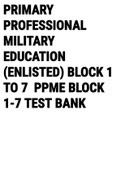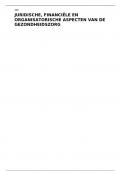Tentamen (uitwerkingen)
COMPLETE TEST BANK FOR FOUNDATIONS OF MATERNAL-NEWBORN AND WOMEN’S HEALTH NURSING 8TH EDITION BY MURRAY! RATED A+
COMPLETE TEST BANK FOR FOUNDATIONS OF MATERNAL-NEWBORN AND WOMEN’S HEALTH NURSING 8TH EDITION BY MURRAY! RATED A+
[Meer zien]












